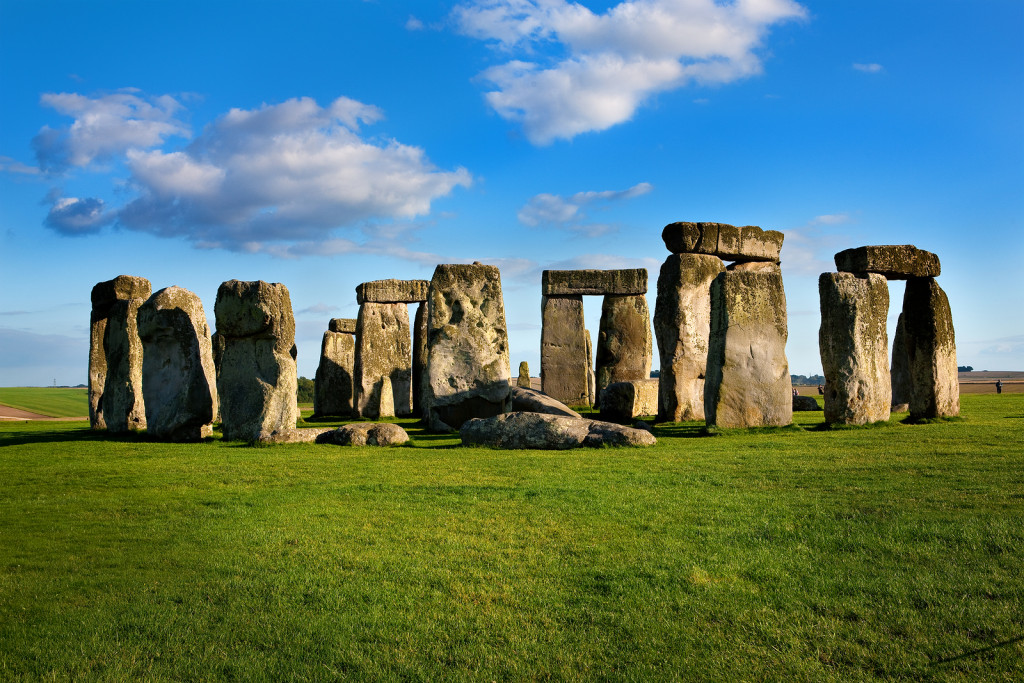Stonehenge is a prehistoric monument located in Wiltshire, England. One of the most famous sites in the world, Stonehenge is the remains of a ring of standing stones set within earthworks. It is in the middle of the most dense complex of Neolithic and Bronze Age monuments in England, including several hundred burial mounds.

History of Stonehenge
Stonehenge evolved in several construction phases spanning at least 1,500 years. There is evidence of large-scale construction on and around the monument that perhaps extends the landscape’s time frame to 6,500 years. Dating and understanding the various phases of activity is complicated by disturbance of the natural chalk by periglacial effects and animal burrowing, poor quality early excavation records, and a lack of accurate, scientifically verified dates.
From what scientists can tell, Salisbury Plain was considered to be a sacred area long before Stonehenge itself was constructed. As early as 10,500 years ago, three large pine posts, which were totem poles of sorts, were erected at the site.
Hunting played an important role in the area. Recently researchers uncovered roughly 350 animal bones and 12,500 flint tools or fragments, just a mile away from Stonehenge, the finds dating from 7500 B.C. to 4700 B.C. The presence of abundant game may have led people to consider the area sacred.
Recently researchers have also discovered a massive wooden building, which may have been used for burial rituals. Also, dozens of burial mounds have been discovered near Stonehenge indicating that hundreds, if not thousands, of people were buried there in ancient times. At least 17 shrines, some in the shape of a circle, have also been discovered near Stonehenge.

As time went on the landscape continued to change. Around 5,500 years ago, two earthworks known as Cursus monuments were erected, the longest of which ran for 1.8 miles (3 km).
More construction occurred around 5,000 years ago with postholes indicating that either bluestones or upright timber posts were propped up on the site. Then, around 4,600 years ago, a double circle made using dozens of bluestones was created at the site.
By 4,400 years ago, Stonehenge had changed again, having a series of sarsen stones erected in the shape of a horseshoe, with every pair of these huge stones having a stone lintel connecting them. In turn, a ring of sarsens surrounded this horseshoe, their tops connecting to each other, giving the appearance of a giant interconnected stone circle surrounding the horseshoe.
By 4,300 years ago, Stonehenge had been expanded to include the addition of two bluestone rings, one inside the horseshoe and another between the horseshoe and the outer layer of interconnected sarsen stones.

Construction at Stonehenge slowed down around 4,000 years ago. As time went on the monument fell into neglect and disuse, some of its stones fell over while others were taken away.
Why was Stonehenge Constucted?
While there have been many theories as to why Stonehenge was constructed, recent discoveries indicate that Stonehenge’s landscape was a sacred area, one that underwent constant change.
“It’s part of a much more complex landscape with processional and ritual activities that go around it,” Gaffney told Live Science, noting that people may have traveled considerable distances to come to Stonehenge.
One new theory about Stonehenge, released in 2012 by members of the Stonehenge Riverside Project, is that Stonehenge marks the “unification of Britain,” a point when people across the island worked together and used a similar style of houses, pottery and other items.
It would explain why they were able to bring bluestones all the way from west Wales and how the labor and resources for the construction were marshaled.
In a news release, professor Mike Parker Pearson of the University of Sheffield said that “this was very different to the regionalism of previous centuries. Stonehenge itself was a massive undertaking, requiring the labour of thousands to move stones from as far away as west Wales, shaping them and erecting them. Just the work itself, requiring everyone literally to pull together, would have been an act of unification.”

